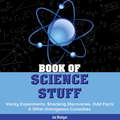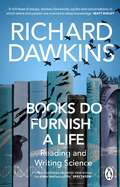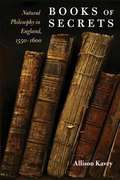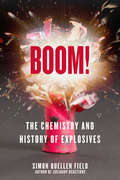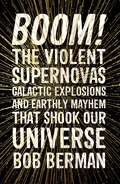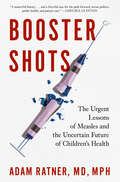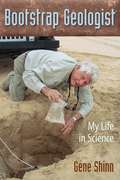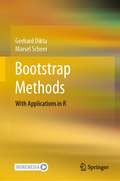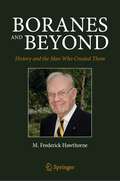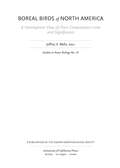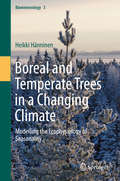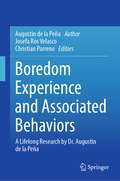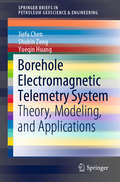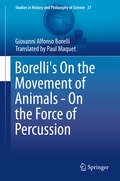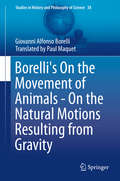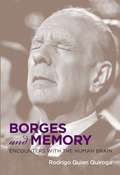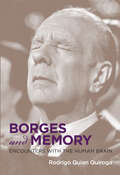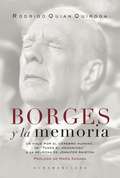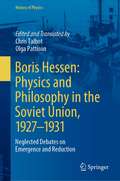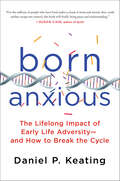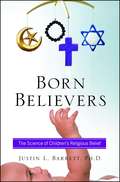- Table View
- List View
Book of Science Stuff
by Joe RhatiganRather than paying tribute to the great discoveries and discoverers, the BOOK OF SCIENCE STUFF takes a fun look at the silly, hilarious, horrible underbelly of science. In a series of enjoyable short accounts, it focuses on the failures, reveals the petty squabbles, and introduces the "nerds" who labored in labs around the world. Check out the blunders--like scary Cold War experiments, idiotic research grants, and space study stupidity; meet the "Sigmund Frauds" and the real Frankensteins; and peek into the secret lives of scientists (if you dare). See how science makes the world go round--and directly affects everyone's daily lives. Scrutinize Hollywood's presentation of science on film and TV. And ponder the ways science sometimes pulls the wool over our eyes.
Books do Furnish a Life: An electrifying celebration of science writing
by Richard Dawkins'A rich feast of his essays, reviews, forewords, squibs and conversations, in which talent and passion are married to deep knowledge.' Matt Ridley'Enjoy the unfailing clarity of his thought and prose, as well as the grandeur of his vision of life on Earth.' - Mark Cocker, Spectator'Richard Dawkins is a thunderously gifted science writer.' Sunday TimesIncluding conversations with Neil DeGrasse Tyson, Steven Pinker, Matt Ridley and more, this is an essential guide to the most exciting ideas of our time and their proponents from our most brilliant science communicator.Books Do Furnish a Life is divided by theme, including celebrating nature, exploring humanity, and interrogating faith. For the first time, it brings together Richard Dawkins' forewords, afterwords and introductions to the work of some of the leading thinkers of our age - Carl Sagan, Lawrence Krauss, Jacob Bronowski, Lewis Wolpert - with a selection of his reviews to provide an electrifying celebration of science writing, both fiction and non-fiction. It is also a sparkling addition to Dawkins' own remarkable canon of work.Plenty of other scientists write well, but no one writes like Dawkins... here is Dawkins the teacher, the scholar, the polemicist, the joker, the aesthete, the poet, the satirist, the man of compassion as well as indignation, the slayer of superstition and, above all, the scientist. - Areo Magazine
Books of Secrets: Natural Philosophy in England, 1550-1600
by Allison KaveyHow cultural categories shaped--and were shaped by--new ideas about controlling nature Ranging from alchemy to necromancy, "books of secrets" offered medieval readers an affordable and accessible collection of knowledge about the natural world. Allison Kavey's study traces the cultural relevance of these books and also charts their influence on the people who read them. Citing the importance of printers in choosing the books' contents, she points out how these books legitimized manipulating nature, thereby expanding cultural categories, such as masculinity, femininity, gentleman, lady, and midwife, to include the willful command of the natural world.
Boom! Bellow! Bleat!: Animal Poems for Two or More Voices
by Georgia HeardA NCTE Notable Poetry BookThis playful collection of poems--peppered with an astounding variety of animal sounds--is meant to be read aloud together.These poems for two or more voices explore the myriad sounds animals make--from a frog's jug-o-rum to a fish's boom! to an elephant's bark. Laced with humor, the poems are a delight to read aloud and cover all major classes of animals: mammals, birds, fish, reptiles, amphibians, insects, even a crustacean! Readers will learn how to estimate the temperature by counting a cricket's chirps and see how creatures make sounds at specific pitches and frequencies, so that they can be heard despite other noise around them. Extensive end notes provide more information on the animals and how and why they make the sounds they do. Written by noted children's poet Georgia Heard, this is an ideal collection for parents and children to share, or for a fun, interactive classroom read-aloud.
Boom!: The Chemistry and History of Explosives
by Simon Quellen FieldBlack powder, the world's first chemical explosive, was originally developed in the seventh century, during China's Tang dynasty. It was a crude mixture at first, but over time chemists discovered the optimum proportion of sulfur, charcoal, and nitrates, as well as the best way to mix them so that the particles of each component were tiny and homogenous, resulting in a complete and powerful reaction. Author and chemistry buff Simon Quellen Field takes readers on a decades-long journey through the history of things that go boom, from the early days of black powder to today's modern plastic explosives. Not just the who, when, and why, but also the how. How did Chinese alchemists come to create black powder? What accidents led to the discovery of high explosives? How do explosives actually work on a molecular scale? And though most people have a vague understanding that dynamite is more powerful than gunpowder, what does it mean to be more powerful? Boom! The Chemistry and History of Explosives goes back to the original papers and patents written by the chemists who invented them, to shed light on their development, to explore the consequences of their use for good and ill, and to give the reader a basic understanding of the chemistry that makes them possible.
Boom!: The Violent Supernovas, Galactic Explosions, and Earthly Mayhem that Shook our Universe
by Bob BermanLooking at the night sky, you&’d be forgiven for thinking it&’s all quiet up there in space. But you&’d be wrong. Extreme events are forever unfolding: galaxies explode, cosmic debris hurtles through the heavens and our own Milky Way is on a collision course with the giant Andromeda galaxy. Mayhem moulded the cosmos, shaped life on Earth and at times threatened to end it. With an enduring sense of wonder, through cataclysms great and small, Bob Berman presents a destructive history of our universe.
Booster Shots: The Urgent Lessons of Measles and the Uncertain Future of Children's Health
by Adam Ratner MD, MPHA pediatrician and infectious disease specialist warns of the resurgence of measles, the antivaccine movement, and how we can prepare for the next pandemicEvery single child diagnosed with measles represents a system failure—an inexcusable unforced error. The technology to prevent essentially 100 percent of measles cases has been in our hands since before the moon landing. But this serious airborne disease, once seemingly defeated, is resurgent around the globe. Why, at a time when biomedical science is so advanced, do parents turn away from vaccination, endangering their own children and the health of the wider population? Using a combination of patient narrative, historical analysis, and scientific research, Dr. Adam Ratner, pediatrician and infectious disease specialist, argues that the reawakening of measles and the subsequent coronavirus pandemic are bellwethers of forgotten knowledge—indicators of decaying trust in science and an underfunded public health infrastructure. Our collective amnesia is starkly revealed in the growth of the antivaccine movement and the missteps in our responses to the beginning of the coronavirus outbreak, leading to preventable tragedies in both cases. Trust in medicine and public health is at a nadir. Declining vaccine confidence threatens a global reemergence of other vaccine-preventable diseases in the coming years. Ratner details how solving these problems requires the use of literal and figurative &“booster shots&” to gather new knowledge and retain the crucial lessons of the past. Learning—and remembering—these lessons is our best hope for preparing for the next pandemic. With attention and care and the tools we already have, we can make the world much safer for children tomorrow than it is today.
Bootstrap Geologist: My Life in Science
by Gene ShinnIn Bootstrap Geologist Shinn enthusiastically shares the highs and lows of his remarkable life. Taking readers around the globe as well as below the ocean, he recounts the painstaking process of data gathering that can lead to paradigm-breaking discoveries. He emphasizes the importance of field science and pointedly addresses the use and abuse of scientific research and the emergence of market-funded research.
Bootstrap Methods: With Applications in R
by Gerhard Dikta Marsel ScheerThis book provides a compact introduction to the bootstrap method. In addition to classical results on point estimation and test theory, multivariate linear regression models and generalized linear models are covered in detail. Special attention is given to the use of bootstrap procedures to perform goodness-of-fit tests to validate model or distributional assumptions. In some cases, new methods are presented here for the first time. The text is motivated by practical examples and the implementations of the corresponding algorithms are always given directly in R in a comprehensible form. Overall, R is given great importance throughout. Each chapter includes a section of exercises and, for the more mathematically inclined readers, concludes with rigorous proofs. The intended audience is graduate students who already have a prior knowledge of probability theory and mathematical statistics.
Boranes and Beyond: History and the Man Who Created Them
by M. Frederick HawthorneTracing the life of a giant in inorganic chemistry and key trends in his science, Boranes and Beyond follows Hawthorne from his mid-American origins to the halls of Harvard and UCLA and back again. It naturally details the accomplishments in his lab. This book is a fascinating mixture of science and autobiography. Prof. Hawthorne won the Priestley Medal, the highest award of the American Chemical Society, for his pioneering work in elucidating the chemistry of boron. He has chronicled in this book the developments in his lab which ultimately led to this achievement.Not content to rest on his laurels, after retiring from UCLA Prof. Hawthorne explored the use of boron in biomedicine and directed the International Institute of Nano & Molecular Medicine at the University of Missouri-Columbia.
Boreal Birds of North America
by Jeffrey V. WellsReaching from interior Alaska across Canada to Labrador and Newfoundland, North America's boreal forest is the largest wilderness area left on the planet. It is critical habitat for billions of birds; more than 300 species regularly breed there. After the breeding season, many boreal birds migrate to seasonal habitats across the United States, Mexico, the Caribbean, and Central and South America. This volume brings together new research on boreal bird biology and conservation. It highlights the importance of the region to the global avifauna and to the connectivity between the boreal forest and ecoregions throughout the Americas. The contributions showcase a unique set of perspectives on the migration, wintering ecology, and conservation of bird communities that are tied to the boreal forest in ways that may not have been previously considered.
Boreal Forests in the Face of Climate Change: Sustainable Management (Advances in Global Change Research #74)
by Yves Bergeron Miguel Montoro Girona Hubert Morin Sylvie GauthierThis open access book explores a new conceptual framework for the sustainable management of the boreal forest in the face of climate change. The boreal forest is the second-largest terrestrial biome on Earth and covers a 14 million km2 belt, representing about 25% of the Earth’s forest area. Two-thirds of this forest biome is managed and supplies 37% of global wood production. These forests also provide a range of natural resources and ecosystem services essential to humanity. However, climate change is altering species distributions, natural disturbance regimes, and forest ecosystem structure and functioning. Although sustainable management is the main goal across the boreal biome, a novel framework is required to adapt forest strategies and practices to climate change. This collaborative effort draws upon 148 authors in summarizing the sustainable management of these forests and detailing the most recent experimental and observational results collected from across the boreal biome. It presents the state of sustainable management in boreal forests and highlights the critical importance of this biome in a context of global change because of these forests' key role in a range of natural processes, including carbon sequestration, nutrient cycling, and the maintaining of biodiversity. This book is an essential read for academics, students, and practitioners involved in boreal forest management. It outlines the challenges facing sustainable boreal forest management within the context of climate change and serves as a basis for establishing new research avenues, identifying future research trends, and developing climate-adapted forest management plans.
Boreal and Temperate Trees in a Changing Climate: Modelling the Ecophysiology of Seasonality (Biometeorology)
by Heikki HänninenThis book provides an overview of how boreal andtemperate tree species have adapted their annual development cycle to theseasonally varying climatic conditions. Therefore, the frost hardy dormant phase, and thesusceptible growth phase, are synchronized with the seasonality of the climate. The volume discusses the annual cycle, including variousattributes such as timing of bud burst and other phenological events, seasonalityof photosynthetic capacity or the frost hardiness of the trees. During the last few decades dynamic ecophysiologicalmodels have been used increasingly in studies of the annual cycle, particularlywhen projecting the ecological effects of climate change. The main emphasis of this volume is oncombining modelling with experimental studies, and on the importance of thebiological realism of the models.
Boredom Experience and Associated Behaviors: A Lifelong Research by Dr. Augustin de la Peña
by Augustin de la PeñaThis book collects the lifelong research on boredom by American psychologist Augustin de la Peña (1942-2021). It focuses on the experience of boredom—and other similar states, including ennui, melancholy, laziness, interest, attention, and entertainment—and its associated behaviors. Offering an interdisciplinary chronicle of boredom, from Antiquity to the present, special attention is paid to its daily experience as a ubiquitous phenomenon that informs cultural and political actions that continue to shape our society. Dr. de la Peña describes the obsolescence of the Western Commonsense View of Reality to propose a Developmental Psychophysiological Approach to Reality, reconceptualizing boredom. The book theorizes the condition as both logical and emotional, an axis that has defined the sensibility of the modern era. This is a volume edited posthumously by Josefa Ros Velasco and Christian Parreno in homage to Augustin’s work and his invaluable contribution to the establishment of the field of boredom studies.
Boredom Is in Your Mind: A Shared Psychological-Philosophical Approach
by Josefa Ros VelascoThis book offers a unique perspective on the topic of boredom, with chapters written by diverse representatives of various mental health disciplines and philosophical approaches. On one hand, studying boredom involves the mental processes of attention, memory, perception, creativity, or language use; on the other, boredom can be understood by taking into account many pathological conditions such as depression, stress, and anxiety. This book seeks to fill the knowledge gap in research by discussing boredom through an interdisciplinary dialogue, giving a comprehensive overview of the past and current literature within boredom studies, while discussing the neural bases and causes of boredom and its potential consequences and implications for individual and social well-being. Chapters explore the many facets of boredom, including:Understanding the cognitive-affective mechanisms underlying experiences of boredomPhilosophical perspectives on boredom, self-consciousness, and narrativeHow boredom shapes both basic and complex human thoughts, feelings, and behavior Analyzing boredom within Freudian and Lacanian frameworks Boredom Is in Your Mind: A Shared Psychological-Philosophical Approach is a pioneering work that brings together threads of cross-disciplinary boredom research into one comprehensive resource. It is relevant for graduate students and researchers in myriad intersecting disciplines, among them cognitive psychology, cognitive neurosciences, and clinical psychology, as well as philosophy, logic, religion, and other areas of the humanities and social sciences.
Borehole Electromagnetic Telemetry System: Theory, Modeling, and Applications (SpringerBriefs in Petroleum Geoscience & Engineering)
by Jiefu Chen Shubin Zeng Yueqin HuangThis book explains the theory, numerical modeling, and applications of a borehole electromagnetic telemetry system used for wireless communication between the downhole tool and the surface control center during oilfield drilling. The authors begin by introducing borehole electromagnetic telemetry and explaining each part of the system with schematics and illustrations. They describe the working principle and compare it with other borehole wireless communication methods, such as mud pulse telemetry. They then address 2D and 3D electromagnetic telemetry modelling, listing previous 2D and 3D modeling methods and detailing the advantages and limitations, before discussing their recent work on a novel layered finite element method for 2D electromagnetic telemetry modelling, and on 3D electromagnetic modelling based on integral equation, thin wire kernel, and layered medium Green’s functions. Lastly, the authors show applications of electromagnetic telemetry, including single well borehole wireless communication and cross well communication in pad drilling. This includes photos, figures, and field data from real oilfield jobs. This book is a useful reference for drilling engineers, well logging tool research and development scientists and researchers, as well as for students in the areas of petroleum engineering and electrical engineering.
Borelli's On the Movement of Animals - On the Force of Percussion (Studies in History and Philosophy of Science #37)
by Giovanni Alfonso BorelliThis volume provides an introduction to Borelli's theory on the movement of animals and demonstrates the nature of the energy of percussion, its causes, properties and effects. Building on and moving away from the theory of mechanics as formulated by Aristotle and Galileo and countering objections expressed by Stephani degli Angeli among others, Borelli presents a completely mechanical account of the action of muscles and analyzes the way in which the center of gravity of the animal shifts in locomotion. Originally published in Italian in 1667, then translated into Latin in 1686, the text of this volume has now been translated into English, making the text accessible to a wide readership. This volume is the first of two volumes that contain the Introduction and physical-mathematical illustrations necessary to understand Giovanni Alfonso Borelli's work On the Movement of Animals, the founding text of seventeenth century biomechanics. The second volume, entitled On The Natural Motions Resulting From Gravity, describes his theory and scientific experiments relating to the natural movements of bodies in a fluid environment.
Borelli's On the Movement of Animals - On the Natural Motions Resulting from Gravity (Studies in History and Philosophy of Science #38)
by Giovanni Alfonso BorelliThis volume provides an introduction to Borelli's theory on the movement of animals and describes his theory and scientific experiments relating to the natural movements of bodies in a fluid environment. It describes in great detail why and how bodies which present with different magnitudes, weights and shapes move at a greater or a smaller velocity in certain proportion in the fluid environment. Originally published in Italian in 1667, then translated into Latin in 1686, the text of this volume has now been translated into English, making the text accessible to a wide readership. This volume is the second of two volumes that contain the Introduction and physical-mathematical illustrations necessary to understand Giovanni Alfonso Borelli's work On the Movement of Animals, the founding text of seventeenth century biomechanics. The first volume, entitled On the Force of Percussion, demonstrates the nature of the energy of percussion, its causes, properties and effects.
Borges and Memory
by Rodrigo Quian Quiroga Juan Pablo FernándezImagine the astonishment felt by neuroscientist Rodrigo Quian Quiroga when he found a fantastically precise interpretation of his research findings in a story written by the great Argentinian fabulist Jorge Luis Borges fifty years earlier. Quian Quiroga studies the workings of the brain--in particular how memory works--one of the most complex and elusive mysteries of science. He and his fellow neuroscientists have at their disposal sophisticated imaging equipment and access to information not available just twenty years ago. And yet Borges seemed to have imagined the gist of Quian Quiroga's discoveries decades before he made them. The title character of Borges's "Funes the Memorious" remembers everything in excruciatingly particular detail but is unable to grasp abstract ideas. Quian Quiroga found neurons in the human brain that respond to abstract concepts but ignore particular details, and, spurred by the way Borges imagined the consequences of remembering every detail but being incapable of abstraction, he began a search for the origins of Funes. Borges's widow, María Kodama, gave him access to her husband's personal library, and Borges's books led Quian Quiroga to reread earlier thinkers in philosophy and psychology. He found that just as Borges had perhaps dreamed the results of Quian Quiroga's discoveries, other thinkers--William James, Gustav Spiller, John Stuart Mill--had perhaps also dreamed a story like "Funes. " With Borges and Memory, Quian Quiroga has given us a fascinating and accessible story about the workings of the brain that the great creator of Funes would appreciate.
Borges and Memory: Encounters with the Human Brain
by Rodrigo Quian QuirogaA scientist's exploration of the working of memory begins with a story by Borges about a man who could not forget. Imagine the astonishment felt by neuroscientist Rodrigo Quian Quiroga when he found a fantastically precise interpretation of his research findings in a story written by the great Argentinian fabulist Jorge Luis Borges fifty years earlier. Quian Quiroga studies the workings of the brain—in particular how memory works—one of the most complex and elusive mysteries of science. He and his fellow neuroscientists have at their disposal sophisticated imaging equipment and access to information not available just twenty years ago. And yet Borges seemed to have imagined the gist of Quian Quiroga's discoveries decades before he made them.The title character of Borges's "Funes the Memorious" remembers everything in excruciatingly particular detail but is unable to grasp abstract ideas. Quian Quiroga found neurons in the human brain that respond to abstract concepts but ignore particular details, and, spurred by the way Borges imagined the consequences of remembering every detail but being incapable of abstraction, he began a search for the origins of Funes. Borges's widow, María Kodama, gave him access to her husband's personal library, and Borges's books led Quian Quiroga to reread earlier thinkers in philosophy and psychology. He found that just as Borges had perhaps dreamed the results of Quian Quiroga's discoveries, other thinkers—William James, Gustav Spiller, John Stuart Mill—had perhaps also dreamed a story like "Funes."With Borges and Memory, Quian Quiroga has given us a fascinating and accessible story about the workings of the brain that the great creator of Funes would appreciate.
Borges y la memoria: Un viaje por el cerebro humano. De "Funes el memorioso" a la neurona de Jennifer
by Rodrigo Quian Quiroga«El trabajo de Quian Quiroga demuestra su conocimiento de la obra deBorges y va dándonos de una manera inefable la unión o la premoniciónentre esa obra y su especialidad, la neurociencia». María Kodama La hiperconectividad del nuevo siglo determina, nos guste o no, un flujoinformativo permanente: vivimos pegados a una pantalla, recibiendodatos. Si no es la TV es el mail, o Facebook, o Twitter, o lacomputadora, o el sms que pasa de goteo a temporal. «Funes el memorioso»se ha hecho realidad: la información abruma y no hay tiempo paradetenerse a pensar. Desde esa perspectiva, el investigador argentinoRodrigo Quian Quiroga produce el extraordinario cruce entre lasneurociencias y la obra de Jorge Luis Borges, y con esas herramientas,que son las mejores posibles, se lanza a explorar los mecanismos querigen nuestra memoria, explica con deslumbrante claridad elcomportamiento de ciertas neuronas y se pone un traje de narrador sobreel uniforme del científico para que el viaje por el cerebro humano queensaya aquí sea tan divertido como revelador.
Boris Hessen: Neglected Debates on Emergence and Reduction (History of Physics)
by Chris Talbot Olga PattisonThis book presents key works of Boris Hessen, outstanding Soviet philosopher of science, available here in English for the first time. Quality translations are accompanied by an editors' introduction and annotations. Boris Hessen is known in history of science circles for his “Social and Economic Roots of Newton’s Principia” presented in London (1931), which inspired new approaches in the West. As a philosopher and a physicist, he was tasked with developing a Marxist approach to science in the 1920s. He studied the history of physics to clarify issues such as reductionism and causality as they applied to new developments. With the philosophers called the “Dialecticians”, his debates with the opposing “Mechanists” on the issue of emergence are still worth studying and largely ignored in the many recent works on this subject. Taken as a whole, the book is a goldmine of insights into both the foundations of physics and Soviet history.
Born Anxious: The Lifelong Impact of Early Life Adversity—and How to Break the Cycle
by Daniel P. KeatingWhy are we the way we are? Why do some of us find it impossible to calm a quick temper or to shake anxiety? The debate has always been divided between nature and nurture, but as psychology professor Daniel P. Keating demonstrates in Born Anxious, new DNA science points to a third factor that allows us to inherit both the nature and the nurture of previous generations—with significant consequences.Born Anxious introduces a new word into our lexicon: “methylated.” It’s short for “epigenetic methylation,” and it offers insight into behaviors we have all observed but never understood—the boss who goes ballistic at the slightest error; the infant who can’t be calmed; the husband who can’t fall asleep at night. In each case, because of an exposure to environmental adversity in utero or during the first year of life, a key stress system has been welded into the “on” position by the methylation process, predisposing the child’s body to excessive levels of the stress hormone cortisol. The effect: lifelong, unrelenting stress and its consequences–from school failure to nerve-wracking relationships to early death.Early adversity happens in all levels of society but as income gaps widen, social inequality and fear of the future have become the new predators; in Born Anxious, Daniel P. Keating demonstrates how we can finally break the cycle.
Born Believers: The Science of Children's Religious Belief
by Justin L. BarrettInfants have a lot to make sense of in the world: Why does the sun shine and night fall; why do some objects move in response to words, while others won’t budge; who is it that looks over them and cares for them? How the developing brain grapples with these and other questions leads children, across cultures, to naturally develop a belief in a divine power of remarkably consistent traits––a god that is a powerful creator, knowing, immortal, and good—explains noted developmental psychologist and anthropologist Justin L. Barrett in this enlightening and provocative book. In short, we are all born believers. Belief begins in the brain. Under the sway of powerful internal and external influences, children understand their environments by imagining at least one creative and intelligent agent, a grand creator and controller that brings order and purpose to the world. Further, these beliefs in unseen super beings help organize children’s intuitions about morality and surprising life events, making life meaningful. Summarizing scientific experiments conducted with children across the globe, Professor Barrett illustrates the ways human beings have come to develop complex belief systems about God’s omniscience, the afterlife, and the immortality of deities. He shows how the science of childhood religiosity reveals, across humanity, a “natural religion,” the organization of those beliefs that humans gravitate to organically, and how it underlies all of the world’s major religions, uniting them under one common source. For believers and nonbelievers alike, Barrett offers a compelling argument for the human instinct for religion, as he guides all parents in how to effectively encourage children in developing a healthy constellation of beliefs about the world around them.
